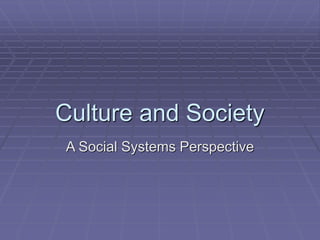
1. Culture and Society.ppt
- 1. Culture and Society A Social Systems Perspective
- 2. Definitions Culture: Those qualities and attributes that seem to be characteristic of all humankind. Humans evolve and adapt primarily through culture rather than changes in anatomy or genetics. Culture survives if it can accommodate to changing conditions. Culture is viewed as a macrosystem. Binds a particular society together, and includes its manners, morals, tools, and techniques.
- 3. Society: A group of people who have learned to live and work together. Society is a holon and within the society, culture refers to the way of life is followed by the group (society).
- 4. Nature of Culture Culture is a group phenomenon. Cultures evolve from the interaction of person with others, and a person’s belief or behavior becomes part of the culture when it is externalized and objectified.
- 5. A culture evolves as each person encounters four “poles”. One’s own body or somatic process. Biological constitution Genetic endowment Other persons or society. Feedback cycle The material world of nonhuman objects. The universe of social constructed meanings.
- 6. According to Erikson, cultures change through the action of persons whose ideas and behavior “fit” the culture. Change can also occur as a result of cataclysm, either physical as in famine, war, epidemic, or disaster. It can also change as a result of a “paradigm shift” in fundamental understandings by those in the culture.
- 7. Unique Aspects of the Human Species The capacity to think. Sets humans apart from most other forms of life. Humans have the capacity to externalize the thought process. Tools Human reproduction Cloning
- 8. The Family as Human Universal The family is biologically based and is the primary social unit. Family is constant; the form of the family is variable. The development of culture exists because culture is transmitted from one generation to the next through education not through the genes.
- 9. Language and Communication Language is defined as any transfer of meaning, but general usage refers only to spoken and written messages. It is essential to be attuned to unspoken and unwritten language. Language structures reality Form and variability determine how members of the culture will view reality and structure their thoughts.
- 10. Territoriality Tendency of people to seek and maintain a territory. The definition of spatial and interactional territories is paramount feature of any culture. Refers to the cultural ways people locate themselves in their universe and establish the boundaries of their various human systems.
- 11. Qualities of a Society Culture is that complex whole that includes knowledge, belief, art, law, morals, custom, and any other capabilities and habits acquired by a human being as a member of society. Culture is viewed as the ways of doing, being, and explaining, as they exist in each particular system.
- 12. Tools Amplifiers of human capacities: Sensory capacity Motor capacity Reasoning and thinking capacity Include devices, objects, and procedures that are extensions of human natural capacities. Tools of a culture include not only understanding their built-in purpose but, their purpose for the user.
- 13. Social Organizations: Society and Roles All cultures, being social systems, have organization. Three aspects operating to define social class: Economic status Social status Political power Social class suggests a group consciousness on the part of members. Emergence of a permanent “underclass” in American society.
- 14. Role relates to and derives from status. Total of the cultural expectations associated with a particular status, including: Attitudes Values Behavior Role expectation are defined by the culture and its components and incorporated by the persons filling the role.
- 15. All persons occupy a complex set of roles: Parent Child Worker Voter Worshipper The total number of roles is influenced by the quantity of networks they are involved in.
- 16. Language Transfer of meaning between systems and between subsystems. Composed of symbols and the meanings are learned and transferred through social interaction. Communication of symbols and their meanings represents the major form of transaction between systems.
- 17. Mead stated that we do not simply respond to the acts of others; we act on our interpretations of their intentions and judgments. A means of setting and maintaining cultural boundaries; also to organize the energies of the system. The importance of screening and interpreting symbols in working with people is quite clear.
- 18. Child Rearing A major task of any culture. As a culture becomes more complex and differentiated, so too does child rearing, and other social provisions appear. These new systems arise to realize more effectively the complex values of a culture. Certain values are in conflict with certain other values, leading to tension and strain within the culture.
- 19. Human Urge to Explain the World Humans are congenitally compelled to impose a meaningful order upon reality. Religion, philosophy, science, and superstition are some of the means. Science continues to be the dominant means of exploring, explaining, and changing our world.
- 20. Social Relations: Caring Cultures are marked by the style in which they conduct social relationships. Caring involves both an emotional disposition and caring labor. It is a practice in which both thought and action are integrated around central aims or goals. Caring is a dimension of culture as much as tools and language.
- 21. A feminist critique states that caring is largely delegated to women by a male-dominated society. Regardless of sex, individuals and groups who occupy subordinate status display a responsive orientation to others characterized by deference, attentiveness, awareness of needs, understanding of perspectives, moods, intentions, and responsiveness.
- 22. An emphasis on autonomy as a basis for caring may be more acceptable to men.